Exhaust ventilation removes exhaust air from rooms where there are sources of pollution. The complete set and characteristics of the exhaust unit vary depending on the purpose of the object. Exhaust ventilation systems successfully work in production, warehouses, kitchens and smoking rooms. Read on to find out how to calculate exhaust ventilation, the types and principles of its operation.
General and local
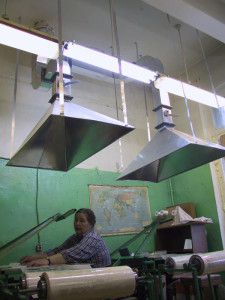
One of the defining parameters for exhaust ventilation systems is the scope. On this basis, local and general exhaust ventilation are distinguished.
General exchange exhaust ventilation its action covers the volume of all rooms in the building. As an example, we can cite the familiar exhaust ventilation in apartments. Exhaust grilles are located in the upper part of the kitchen and bathroom, through which exhaust air should be drawn from the entire apartment. General exhaust ventilation is effectively used in residential construction, storage facilities, sports and health facilities, shops and shopping centers. That is, where the concentration of harmful substances in the air is low and they are evenly dissolved throughout the entire volume of the room.
The general type of exhaust ventilation is set up when:
- hazardous substances penetrate into the air of the room, because machines and mechanisms cannot be sealed;
- there are no specific points of release of hazardous substances;
- local hoods cannot cope.
General exchange exhaust ventilation reduces the content of hazardous types of impurities in the air of the entire room to the maximum permissible concentration.
Local or local exhaust ventilation system necessary where harmful or hazardous substances are released into the air pointwise. It provides a normal working environment for workers right at their workplace. Exhaust pipes are brought here, which collect dust, hot air, smoke, poisonous fumes and carry them out, preventing them from spreading. A good example of a local exhaust ventilation system is mechanical hoods in kitchens. The equipment of the local exhaust ventilation system is much cheaper than the general exchange one, and the amount of exhaust air is less. This means the equipment is more economical. But if the pollution is dispersed in the air, the local exhaust ventilation system is ineffective.
Natural and forced
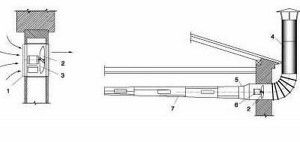
The principle of operation of any exhaust ventilation system is to evacuate the exhaust air. Various methods are used to implement it. The exhaust ventilation system can be natural or compulsory... When the movement of air masses occurs according to the laws of nature, ventilation is called natural. In mechanical exhaust ventilation, air is moved only by means of equipment. Mechanical ventilation is fully automated, the volume of the exhaust and inflow is known in advance and corresponds to the design standards.
Advantages and Disadvantages of Natural Ventilation
The main advantage of natural exhaust ventilation in an apartment is its low cost. Its arrangement does not require serious costs, and its operation is completely free, no equipment for air exchange is required.The second advantage is that exhaust ventilation accessories do not take up much space.
A serious drawback of this type of exhaust ventilation is the unpredictability and uncontrollability of its operation. Air movement occurs due to the difference in air indicators at the ends of the exhaust pipes. Therefore, under certain conditions, there may be no thrust.
When the house is colder than outside, the exhaust ventilation can turn into supply ventilation, drawing air into the apartment from the outside. For this reason, natural ventilation is installed in residential premises and less often in industrial premises.
In production where a guaranteed outflow of air is required, this principle of operation of exhaust ventilation is not efficient enough and may even be dangerous.
Exhaust ventilation calculation
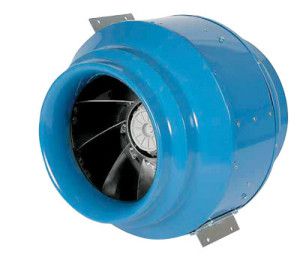
The calculation of exhaust and supply ventilation of industrial premises begins with the identification of sources of toxic or explosive emissions. Next, the flow rate of the supply and exhaust air is calculated, sufficient to ensure sanitary standards. If there are no sources of harmful substances in the room, the calculation of exhaust ventilation is limited by the formula:
O=m * n,
here: ABOUT - the volume of air, regulated by sanitary standards; m - fresh air consumption per worker per hour; n - the number of employees.
The quantity m determined by SNiP for each employee:
- in the presence of ventilators m = 30 cubic meters per hour;
- without air flow m = 60 cubic meters per hour.
If during the production process harmful or hazardous substances are released, the calculations take into account their quantity and the need to supply fresh air for breathing of workers.
Often, harmful substances are emitted throughout the entire volume of the workshop and it is necessary to reduce their concentration to the maximum permissible concentration at the place where people are located, and then remove it using mechanical exhaust ventilation. The MPC standards can be found in special literature, for each harmful substance there is a threshold. Let's calculate the volume of fresh air required for dilution to the maximum permissible concentration:
O = MV \ (Ko-Kp),
here: Mv - the weight of the harmful substance entering the air in 1 hour; To - specific concentration of harmful substances in the air of the room; Kp - concentration of harmful substances in the supply. Knowing the required air volume, it is possible to select the engine power for the exhaust ventilation.
If several harmful substances are emitted in the workshop, calculations are performed for each of them separately and then summed up. To determine the total air balance of the room, the costs of all local exhaust ventilation for soldering and the total inflow are added.
To determine the amount of supply air, we calculate the excess heat:
W = Ol + [3,6q - c * Ol (Tr - Tp) / c (T1-Tp)],
here: Ol - volume of air removed by local extractors; q - the amount of heat generated by machines and products; c - heat capacity, taken from the reference book, equals 1.2; Tr - temperature of the air removed from the working area; Tp - inflow temperature; T1 - the temperature of the air removed from the entire room.
Natural type
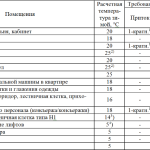
Let's consider how to calculate natural exhaust ventilation. With this type of air exchange, the exhaust air is drawn through the shafts. To replace it, fresh air from the street enters through specially equipped or spontaneously arising cracks.
We calculate the pressure difference at the ends of the exhaust duct in Pascals:
∆H=g*L(Ωh-Ωb),
here: g - 9.8 - acceleration of gravity, L - duct length, Ωh - the density of the air outside, Ωb - the density of the air in the duct.
During aeration, the amount of air penetrates into the room, determined by the formula:
O=3,6*Q/(tv—tp),
here: 3,6 - specific heat, Q - total heat gain, tv - blowing temperature, tp - inflow temperature.
For the longest duct, a pressure loss is calculated equal to the total pressure loss of all sections.
In one section, the pressure loss is calculated as follows:
P=r*L + z,
here r - pressure loss on the segment, L - the length of the section of the air duct, z - losses from resistance.
Equipment for local exhaust ventilation
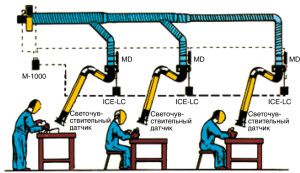
Exhaust ventilation shelters are divided into three categories:
- located outside the source of pollution;
- completely overlapping the selection source;
- blowouts.
The method of localizing harmful secretions with the help of shelters covering the source is very effective. But the technological process does not always allow the use of such a principle of operation of the exhaust ventilation. Other local exhaust ventilation devices:
- fume hoods;
- suction;
- exhaust umbrellas;
- onboard, shaped and display type suction;
- removal of secretions directly from machine cavities;
- encapsulation (the machine is installed in a capsule).
Suction must pull out harmful impurities with the lowest air consumption. In production, suction is often used, for example, as a local exhaust ventilation for soldering. An important condition: accessories for exhaust ventilation must provide access to the machines without interfering with the work of employees.
Exhaust umbrella Is the most common example of suction. Umbrellas are installed to collect hazardous contaminants that rise upward, for example, as local exhaust ventilation for soldering tables. Exhaust hoods can be operated with forced or natural draft.
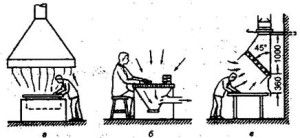
Pull out drobe removes harmful substances in the best way, creating a minimum air exchange. Cabinets are:
- with top suction to collect moist and hot air;
- with bottom and combined suction for collecting heavy vapors and gases;
- with side suction and "snail" fan for collecting dust.
The motor and exhaust fan create a swirl of air, preventing dust from spreading throughout the room. An example is the exhaust ventilation at a welding station. For welding of small parts at the posts, ventilation hoods with upper suction and sliding shelter are equipped.
When working with non-toxic substances, the speed of air movement at the inlet to the device should be:
- 0.6 - 0.7 m / s,
- up to 1.1-1.5 m / s for suction of toxic impurities (including vapors of heavy metals).
Suction panels it is advisable to use when dust, poisonous gases and heat are released into the air. The panel is placed so that the flow of toxic substances passes as far as possible from the face of the employee and is connected to the exhaust ventilation motor by air ducts. The panels are installed, for example, as an exhaust ventilation of welding stations, where they work with large products. Panels of two- or one-sided suction, hang at a distance of no more than 3.5 m from the welding place. For the suction panel, the air velocity should be:
- when working with hot dust 3.6 - 4.5 m / s;
- when working with poisonous, non-dusty secretions - 2.1 - 3.5 m / sec.
Each square meter of the panel must draw 3300 cubic meters of air per hour.
Onboard suction used in cases where the object of hazardous emissions is held by vertical lifters, that is, the space above it cannot be occupied. For example, in electroplating workshops, harmful substances spread over the surface of the solution poured into the bath and are gradually sucked into the suction slot. On-board suction systems are air ducts with narrow inlet openings up to 100 mm in diameter, located along the edges of the bath.
Calculation of parameters of local exhaust devices
To suck in harmful substances directly in the place of their release in production, suction units in the form of umbrellas are most often installed. If the equipment supplier does not supply umbrellas, they are made, guided by the drawing:
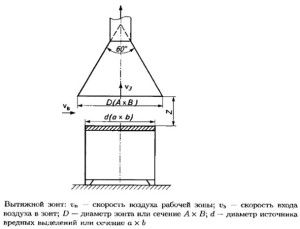
Before calculating an exhaust ventilation umbrella, it is necessary to determine:
- diameter (d) or the dimensions of the ejection area (a x b);
- suction speed of air into the umbrella (Vz);
- air speed in the working area (Vв);
- the height of the umbrella installation above the source of pollution (Z).
A very important indicator that determines the effectiveness of the collection of contaminants is the height of the umbrella installation. Therefore, it is advisable to hang it as low as possible.
We calculate the size of the umbrella:
A=0,8*Z+a, B=0,8*Z+borD=0,8*Z+d,
To prevent stagnation zones from forming at the edges of the catching device, the opening angle should be less than 60 degrees. In very low rooms, it is allowed to increase the opening angle up to 90 degrees. The height of the lower edge of the umbrella should be no more than 180 cm above the floor. If the air speed in the room is more than 0.4 m / s, the umbrella is equipped with folding curtains that cut off the flow of polluted air on three sides. The above calculations will help you to select the equipment in advance and determine the price. But in order to calculate in detail the exhaust ventilation, you need to contact a specialist.
Do-it-yourself exhaust ventilation
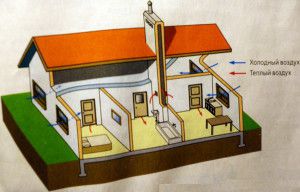
The easiest way is to equip exhaust ventilation with your own hands in a private house. We extend the exhaust duct from each ventilated room strictly vertically. Turns and bends reduce traction. Any protrusions, irregularities and changes in the diameter of the ventilation pipe also negatively affect the air speed. The canal ends above the roof of the house. The section of the exhaust duct must be at least 100 sq. cm, it is desirable to calculate it more accurately. Circular exhaust ducts are more efficient, as they create less resistance to air (the shorter the length of the perimeter, the less resistance).
If you equip the exhaust ventilation of a house with your own hands at the stage of its construction, you can hide the mines in the walls. Otherwise, you will have to additionally drill floors, stretch pipes or attach a brick box for the mine.
The exit of the mine above the roof is made out by hand with an exhaust ventilation umbrella, which covers the opening from precipitation and litter. It is advisable to install a deflector instead of an umbrella. It costs a little more, but it increases the thrust in the mine.
Mechanical exhaust system
Exhaust ventilation systems are produced by domestic and foreign companies: WentMashine, Alfa Vent. So, WentMashine produces exhaust ventilation systems from European components.
| Number of fan speeds | 4 |
| Performance | 260-700 cubic meters per hour |
| Input noise | 28-39 decibels |
| Fan power | 0.195 kW |
| Dimensions, cm | 52.8x45.7x28.8 |
| Weight | 16.3 kg |
| Place of installation | Outside \ inside |
Table 1. Characteristics of the BW-700 exhaust unit
The cost of exhaust ventilation systems from the manufacturer is 33-129 thousand rubles, depending on the capacity. It is impractical to use exhaust ventilation units in apartments and country houses. After all, it is necessary at the same time to provide a full flow of air from the street. Household supply valves and window ventilators cannot cope with this task.
Mechanical exhaust ventilation with a powerful motor and air duct system is suitable for commercial, public and industrial premises, where, in combination with an air supply unit, it creates a full air exchange.
Video on how to equip workshop exhaust ventilation with your own hands:

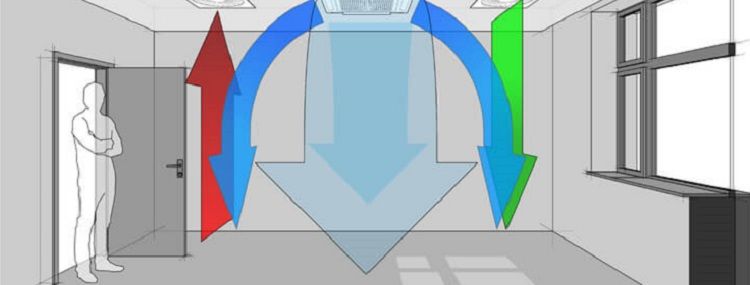

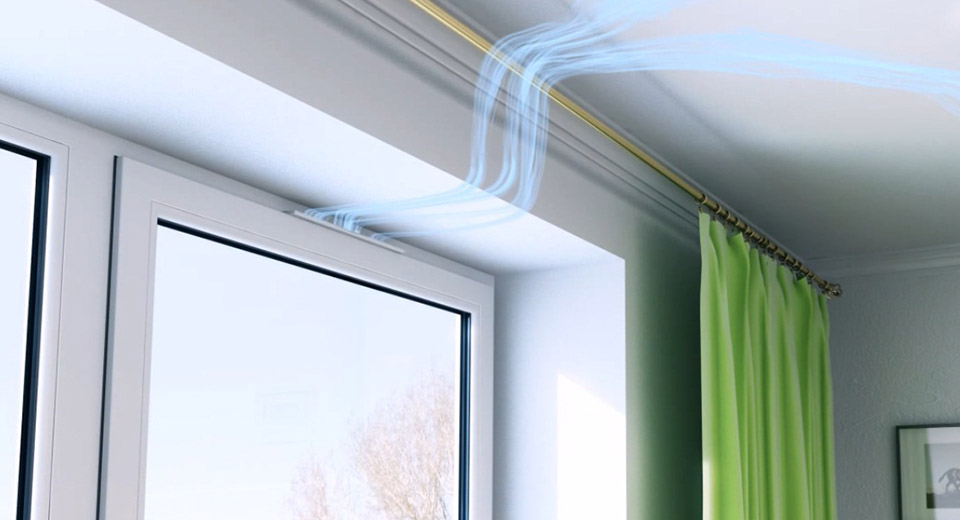
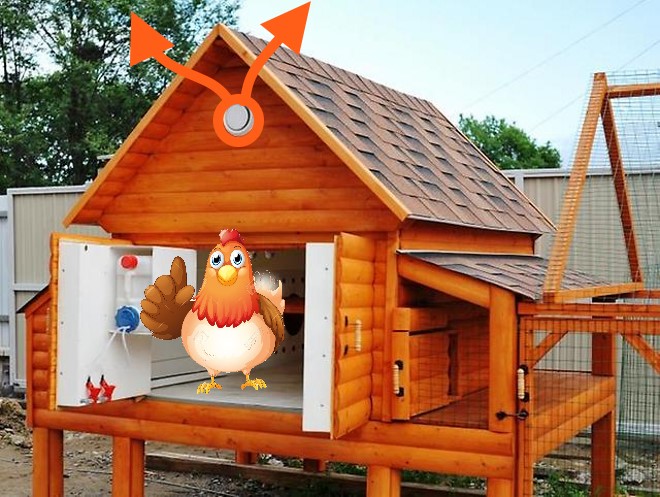
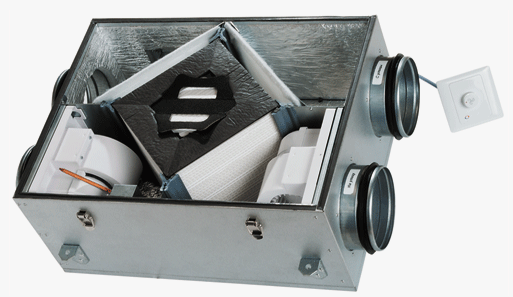

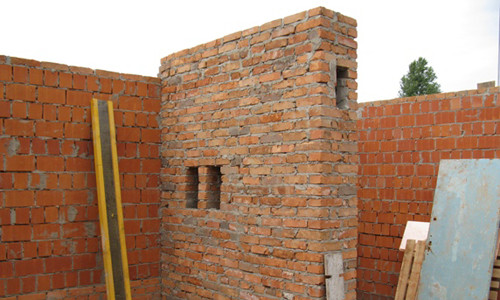

How to calculate the required ventilation for the prom. premises with an area of 43 sq. m?
With an area of 43 squares, a ceiling height of 3 m and an air exchange rate of 2, you will need a capacity of 258.00 m³ / h.